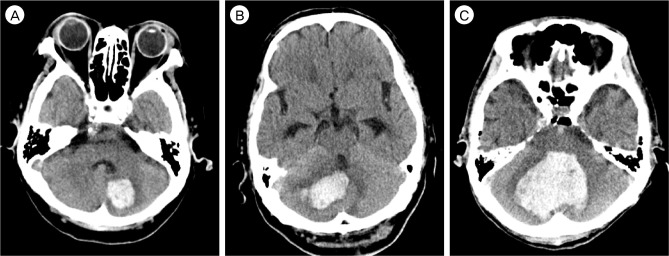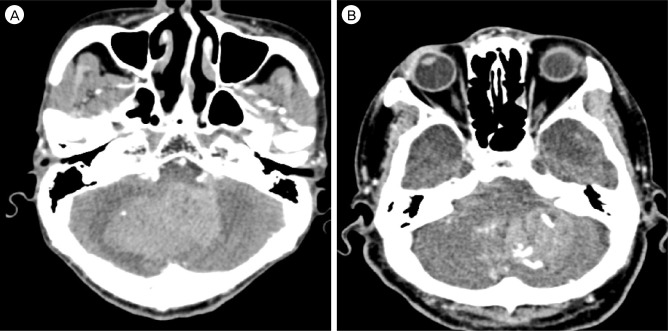J Cerebrovasc Endovasc Neurosurg.
2015 Sep;17(3):185-193. 10.7461/jcen.2015.17.3.185.
Management and Outcome of Spontaneous Cerebellar Hemorrhage
- Affiliations
-
- 1Department of Neurosurgery, Kangnam Sacred Heart Hospital, Hallym University College of Medicine, Seoul, Korea. leehokook@me.com
- KMID: 2069242
- DOI: http://doi.org/10.7461/jcen.2015.17.3.185
Abstract
OBJECTIVE
Spontaneous cerebellar hemorrhage (SCH) is less common than supratentorial intracerebral hemorrhage. This study investigated the treatment of SCH and the relation between its clinical and radiological manifestation and outcome.
MATERIALS AND METHODS
We presented a SCH management protocol in our institute and analyzed the clinical and radiological findings in 41 SCH patients. The outcomes of each method (surgery and conservative treatment) were compared among patients with initial Glasgow Coma Scale (GCS) score of 9-13 and hematoma volume greater than 10 mL.
RESULTS
Two (4.9%), 16 (39%), and 23 (56.1%) patients had an initial GCS score of 3-8, with 3-8, 9-13, and 14-15, respectively. Initial GCS score showed significant correlation with Glasgow Outcome Scale (GOS) score (p = 0.005). The mean largest hematoma diameter was 3.2 +/- 1.5 cm, and the mean volume was 11.0 +/- 11.5 mL. Both of them showed significant inverse correlation with GOS score (p < 0.001). Among patients with an initial GCS score of 9-13 and hematoma volumes greater than 10 mL, 3 (50%) had good outcome and 3 (50%) had poor outcome in the surgical, and all of those in the conservative treatment group had poor outcomes. The outcome distribution differed significantly in the surgical and conservative groups (p = 0.030).
CONCLUSION
Initial GCS score and largest hematoma diameter and volume on brain computed tomography are important determinants of outcome in SCH patients. The surgery group showed better outcome than the conservative treatment group among those with an intermediate neurological status and large hematomas.
MeSH Terms
Figure
Reference
-
1. Cho SM, Hu C, Pyen JS, Whang K, Kim HJ, Han YP, et al. Predictors of outcome of spontaneous cerebellar hemorrhage. J Korean Neurosurg Soc. 1997; 10. 26(10):1395–1400.2. Cohen ZR, Ram Z, Knoller N, Peles E, Hadani M. Management and outcome of non-traumatic cerebellar haemorrhage. Cerebrovasc Dis. 2002; 10. 14(3-4):207–213. PMID: 12403953.
Article3. Dahdaleh NS, Dlouhy BJ, Viljoen SV, Capuano AW, Kung DK, Torner JC, et al. Clinical and radiographic predictors of neurological outcome following posterior fossa decompression for spontaneous cerebellar hemorrhage. J Clin Neurosci. 2012; 9. 19(9):1236–1241. PMID: 22721890.
Article4. Dammann P, Asgari S, Bassiouni H, Gasser T, Panagiotopoulos V, Gizewski ER, et al. Spontaneous cerebellar hemorrhage--experience with 57 surgically treated patients and review of the literature. Neurosurg Rev. 2011; 1. 34(1):77–86. PMID: 20697766.
Article5. Davis SM, Broderick J, Hennerici M, Brun NC, Diringer MN, Mayer SA, et al. Hematoma growth is a determinant of mortality and poor outcome after intracerebral hemorrhage. Neurology. 2006; 4. 66(8):1175–1181. PMID: 16636233.
Article6. Dolderer S, Kallenberg K, Aschoff A, Schwab S, Schwarz S. Long-term outcome after spontaneous cerebellar haemorrhage. Eur Neurol. 2004; 9. 52(2):112–119. PMID: 15319556.
Article7. Han JH, Lee JM, Koh EJ, Choi HY. The spot sign predicts hematoma expansion, outcome, and mortality in patients with primary intracerebral hemorrhage. J Korean Neurosurg Soc. 2014; 10. 56(4):303–309. PMID: 25371779.
Article8. Hill MD, Silver FL. Epidemiologic predictors of 30-day survival in cerebellar hemorrhage. J Stroke Cerebrovasc Dis. 2001; May-Jun. 10(3):118–121. PMID: 17903811.
Article9. Kirollos RW, Tyagi AK, Ross SA, van Hille PT, Marks PV. Management of spontaneous cerebellar hematomas: a prospective treatment protocol. Neurosurgery. 2001; 12. 49(6):1378–1386. discussion 1386-7PMID: 11846937.
Article10. Kothari RU, Brott T, Broderick JP, Barsan WG, Sauerbeck LR, Zuccarello M, et al. The ABCs of measuring intracerebral hemorrhage volumes. Stroke. 1996; 8. 27(8):1304–1305. PMID: 8711791.
Article11. Little JR, Tubman DE, Ethier R. Cerebellar hemorrhage in adults. Diagnosis by computerized tomography. J Neurosurg. 1978; 4. 48(4):575–579. PMID: 632882.
Article12. Luparello V, Canavero S. Treatment of hypertensive cerebellar hemorrhage--surgical or conservative management? Neurosurgery. 1995; 9. 37(3):552–553. PMID: 7501127.
Article13. Matsukawa H, Shinoda M, Fujii M, Takahashi O, Yamamoto D, Murakata A, et al. Relationships among hematoma diameter, location categorized by vascular territory, and 1-year outcome in patients with cerebellar hemorrhage. World Neurosurg. 2012; Mar-Apr. 77(3-4):507–511. PMID: 22120383.
Article14. Matsukawa H, Shinoda M, Yamamoto D, Fujii M, Murakata A, Ishikawa R, et al. Antiplatelet agents are risk factors for cerebellar hemorrhage in patients with primary intracerebral hemorrhage. J Stroke Cerebrovasc Dis. 2011; Jul-Aug. 20(4):346–351. PMID: 20656513.
Article15. Moon BH, Jang DK, Han YM, Jang KS, Huh R, Park YS. Association Factors for CT Angiography Spot Sign and Hematoma Growth in Korean Patients with Acute Spontaneous Intracerebral Hemorrhage : A Single-Center Cohort Study. J Korean Neurosurg Soc. 2014; 10. 56(4):295–302. PMID: 25371778.
Article16. Moon KS, Park HK, Yoon SM, Bae HG, Yun IG, Choi SK. Outcomes in the management of spontaneous cerebellar hemorrhage. J Korean Neurosurg Soc. 2006; 10. 40(4):234–238.17. Morgenstern LB, Hemphill JC 3rd, Anderson C, Becker K, Broderick JP, Connolly ES Jr, et al. Guidelines for the management of spontaneous intracerebral hemorrhage: a guideline for healthcare professionals from the American Heart Association/American Stroke Association. Stroke. 2010; 9. 41(9):2108–2129. PMID: 20651276.18. Park SY, Kong MH, Kim JH, Kang DS, Song KY, Huh SK. Role of 'Spot Sign' on CT angiography to predict hematoma expansion in spontaneous intracerebral hemorrhage. J Korean Neurosurg Soc. 2010; 11. 48(5):399–405. PMID: 21286475.
Article19. Pong V, Chan KH, Chong BH, Lui WM, Leung GK, Tse HF, et al. Long-Term Outcome and Prognostic Factors After Spontaneous Cerebellar Hemorrhage. Cerebellum. 2012; 12. 11(4):939–945. PMID: 22392071.
Article20. Saloheimo P, Ahonen M, Juvela S, Pyhtinen J, Savolainen ER, Hillbom M. Regular aspirin-use preceding the onset of primary intracerebral hemorrhage is an independent predictor for death. Stroke. 2006; 1. 37(1):129–133. PMID: 16322483.
Article21. Salvati M, Cervoni L, Raco A, Delfini R. Spontaneous cerebellar hemorrhage: clinical remarks on 50 cases. Surg Neurol. 2001; 3. 55(3):156–161. discussion 161PMID: 11311913.
Article22. St Louis EK, Wijdicks EF, Li H, Atkinson JD. Predictors of poor outcome in patients with a spontaneous cerebellar hematoma. Can J Neurol Sci. 2000; 2. 27(1):32–36. PMID: 10676585.23. Toyoda K, Okada Y, Minematsu K, Kamouchi M, Fujimoto S, Ibayashi S, et al. Antiplatelet therapy contributes to acute deterioration of intracerebral hemorrhage. Neurology. 2005; 10. 65(7):1000–1004. PMID: 16217049.
Article24. Wada R, Aviv RI, Fox AJ, Sahlas DJ, Gladstone DJ, Tomlinson G, et al. CT angiography "spot sign" predicts hematoma expansion in acute intracerebral hemorrhage. Stroke. 2007; 4. 38(4):1257–1262. PMID: 17322083.
Article25. Wu YT, Li TY, Chiang SL, Chu HY, Chang ST, Chen LC. Predictors of first-week mortality in patients with acute spontaneous cerebellar hemorrhage. Cerebellum. 2013; 4. 12(2):165–170. PMID: 22907124.
Article26. Yanaka K, Meguro K, Fujita K, Narushima K, Nose T. Immediate surgery reduces mortality in deeply comatose patients with spontaneous cerebellar hemorrhage. Neurol Med Chir (Tokyo). 2000; 6. 40(6):295–299. discussion 299-300PMID: 10892265.
- Full Text Links
- Actions
-
Cited
- CITED
-
- Close
- Share
- Similar articles
-
- Spontaneous Acute Cerebellar Hemorrhage
- Predictors of Outcome of Spontaneous Cerebellar Hemorrhage
- The Management of Spontaneous Intracerebral Hemorrhage: Medical Versus Surgical Therapy for Spontaneous Intracerebral Hemorrhage
- Cerebellar Hemangioblastoma:Hemorrhage as an Initial Presentation: Case Report
- Prognostic Factors in Spontaneous Cerebellar Hemorhage and Pontine Hemorrhage



